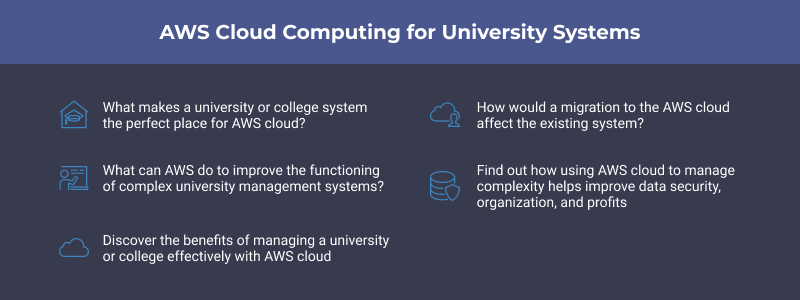AWS cloud computing for universities & colleges
At the beginning of the COVID pandemic, many colleges and universities discovered the advantages of accessibility, flexibility, and organizational impact of migrating to cloud computing. COVID forced organizations with often highly complex systems representing multiple computing groups and data to provide effective and accessible systems for staff and students. Online learning, remote work, and constant communication through various channels have since become the norm.
Students and staff have adapted and expect even more from colleges and university systems. Digital transformation has brought highly cost-effective, secure, and scalable cloud system infrastructure, like AWS Cloud. The AWS cloud (amazon web services) represents the future of system management that supports complex and highly connected systems like those traditionally used by colleges and universities.
This guide describes how university and college management benefits from using AWS cloud to manage students, staff, and services securely.

What makes a university or college system the perfect place for AWS cloud?
A university system is a perfect place to use the AWS cloud because of the vast amount of data and the complex series of loosely integrated systems that support staff, students, and faculty. Universities are managed like businesses and involve both support for students and staff as well as the management side, including CRM, financial processing, project management, development, and research programs.
Higher education institutions provide education across broader and more diverse populations. The ability to effectively support students with a personalized learning experience becomes critical to maintaining a reliable income stream. The AWS cloud provides a fully managed and secure system for any organization, regardless of size and complexity.
Keeping students and an effective income stream requires adapting and modernizing digital systems. Systems must be fast, secure, and accurately leverage data for business intelligence uses. Business intelligence analytics provide actionable data sets across the organization for making informed decisions based on real-time data. University customers include internal staff, faculty, and students.
78% of college and university presidents view the COVID pandemic as the catalyst for management transformation and as an opportunity for sustainable growth. Organizations that adopt and use integrated technologies, including universities and colleges, will be integral to building the future. The future involves managing and leveraging data to solve problems before negatively affecting the business.
What can AWS do to improve the functioning of complex university management systems?
Using AWS cloud enables universities and colleges to manage organizations sustainably and cost-effectively while supporting students, staff, and faculty. University system management includes not only support for students, but also operational management, including financials, payroll, human resources, and scientific research projects.
Each group needs a high-performance system that’s available and accessible whenever needed. The additional bonus of shared data and flexible setup strengthens the case for modernizing with the AWS cloud.
Benefits of AWS cloud for higher education systems include:
- Improved student experience through personalized engagement
- 24/7 digital access for students, staff, and faculty
- AI and ML technology for education support and equitable communication options
- Shared data across the system for accurate business intelligence and making informed decisions
- Fully connected systems that work with each other seamlessly
- Improved collaboration between students, faculty, and staff
- Improve time spent on scientific research instead of supporting and building computing systems
- Access to numerous integrated options to build a system suite to meet the entire communities needs
- Development of knowledgebases and documented procedures for staff and faculty
Data is the core of modernizing systems and can be leveraged easily within the AWS cloud. Instead of managing diverse, siloed datasets for operations, student information systems, and learning management systems, compliance systems all with individual security and server systems. The AWS cloud provides a single, integrated solution where all the data is available for improving the organization across the board.
The AWS cloud also offers a disaster-recovery-as-a-service solution. The automated solution ensures that an organization’s data is not only fully and consistently secured but is replicated and stored continuously in case of disaster. In minutes, the system can recover and launch thousands of machines in a fully provisioned and working state—no need to manage and finance data centers or create and manage duplicate servers. The AWS cloud can keep and restore everything in working order immediately.
How would a migration to the AWS cloud affect the existing system?
Migrating existing applications takes planning and strategy, not interrupting the live system until the transfer is complete and verified. Switching to a managed service within a cloud architecture requires extensive planning and a step-by-step approach. AWS approaches all large-scale migrations using three phases: assess, mobilize, and migrate. The phases cover mobilizing the workforce and resources and setting up automation to migrate applications quickly and accurately without interruption to the existing live system.
Migrating to the AWS cloud includes the AWS Application Migration Service, where a primarily automated rehosting solution simplifies, monitors, and performs data and application migration processing.
The AWS application migration service (AWS MGN) enables organizations to lift and shift any number of physical or virtual servers to the cloud without compatibility issues, performance problems, or long, slow transfer windows.
The lift-and-shift migration process is often called rehosting. When an extensive system needs to be migrated, rehosting enables the existing system to function while the migration continues in the background. With AWS, a complete migration of a complex system takes weeks rather than months or years. Once the migration is completed, the AWS MGN service automatically launches and converts servers to AWS, so the organization benefits from the cost savings, productivity, and security nearly immediately.
Are you ready to harness the power of AWS Cloud?
Colleges and universities are digitally transforming to access cost savings, scalability, secure, flexible, and high-performing systems that align users and data across the entire system. Modernize teaching, learning, and operational support by leveraging connected data to improve revenue and growth. How can AWS help your organization modernize and help build the future?
Do you need managed services or cloud solutions? Have questions on what you need or how to proceed? CloudHesive provides support and deep expertise in using the entire AWS cloud and infrastructure system. As an Amazon Managed Services partner and Amazon Premier Partner, CloudHesive helps any organization take full advantage of all the AWS features. See what other customers have to say in case studies available from CloudHesive.



